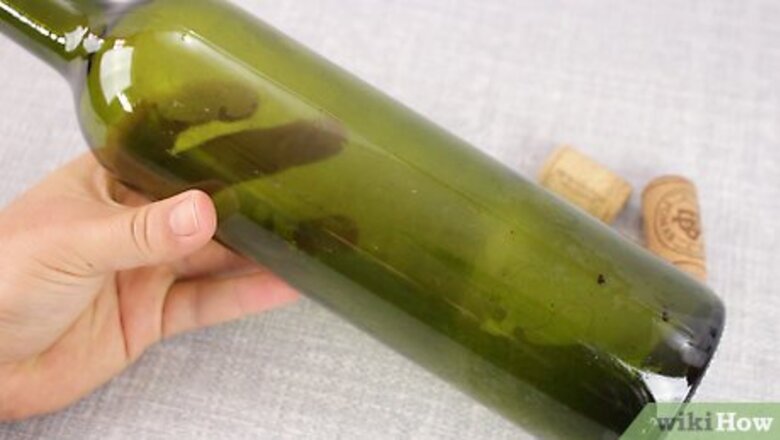
views
- Score around the circumference of the wine bottle with a glass cutter, then run the bottle under hot and then cold water, alternating, until it splits along the score.
- Measure and cut a chain or string about 17 in (43 cm) long and attach a key ring to one end. Thread the free end up through the bottle’s neck.
- Attach another chain with a key ring to the ring inside the bottle, then add a wind catch like a necklace pendant to the bottom.
Cutting the Bottle
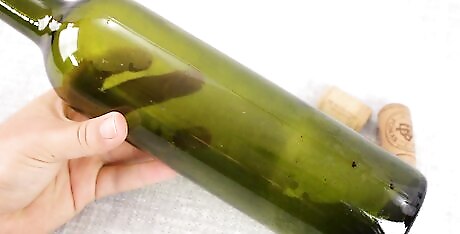
Remove the cork and label from an empty wine bottle. Grab your leftover wine bottle and discard the cork (or save it for other crafts). Then, use your fingers to peel as much of the label from the bottle as you can. To remove the rest, saturate the label with warm water and dish soap and rub it away with a sponge. If it’s stubborn, sprinkle ½ tsp (3 g) of baking soda over the label and continue rubbing with a sponge until the label is completely gone. After, rinse the bottle with warm water to remove any residue and ensure the bottle is squeaky clean. Completely removing the label makes cutting the bottle much easier and neater in the following steps.
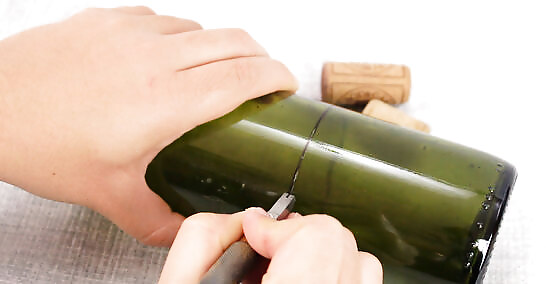
Score a line around the bottle with a glass cutter tool. Wearing a sturdy pair of work gloves and eye protection, place the bottle on a stable surface. Place the cutting edge of the glass cutter tool onto the bottle, about ¾ of the way from the top of the bottle. While applying firm but gentle pressure, roll the bottle away from you, keeping the glass cutter pressed to its surface, to score a straight line all the way around the circumference of the bottle. Alternatively, cut your wine bottle using a string soaked in acetone. The string is wrapped around the bottle and lit on fire for a few moments, then the bottle dunked in water to split it. Or, use a specialized bottle cutting tool to make the process easier if you’ll be making a few windchimes. Optionally, use a round metal clamp or tie a string around the bottle to act as a guide while you cut.
Dip the bottle in boiling water, then ice water to split it. Heat a kettle full of water to boiling, then pour it over the score in the bottle for 30 seconds while holding the bottle by its neck over a sink. Then, run the score of the bottle under cold water, or dunk it into an ice bath. The rapid change in heat causes the glass to fluctuate, breaking it along the scored line. Alternatively, dunk the bottle in a pot of just-boiled water, then dunk it in the ice bath, and repeat until it splits. Discard the bottom half of the bottle, or keep it to place candles into or make other crafts with. Just be sure to sand and polish the cut edge for safety. EXPERT TIP Douglass Brown Douglass Brown Glassblowing Expert Douglass Brown is a Glassblowing Expert based in Half Moon Bay, California. He has over 25 years of experience as a glass artist, and is the owner and operator of 2 glass blowing studios in the San Francisco Bay Area, Half Moon Bay Art Glass and Mare Island Art Glass. Douglass believes in sharing hot glass experiences with anyone who wants to learn about the processes of blowing and sculpting glass. When not teaching, Douglass creates glass art that is a mix of his takes on nature and functional glassware. He has also created the Glass Troubadours, which is a mobile glass blowing studio that hosts parties, events, and visits craft shows. Douglass Brown Douglass Brown Glassblowing Expert You can use the hot-popping method as an alternative. Start by scoring the bottle, then use a small butane torch as your heat source. Place the bottle on a record player or Lazy Susan to keep it spinning. This method eliminates the need for running the bottle under hot and cold water multiple times.
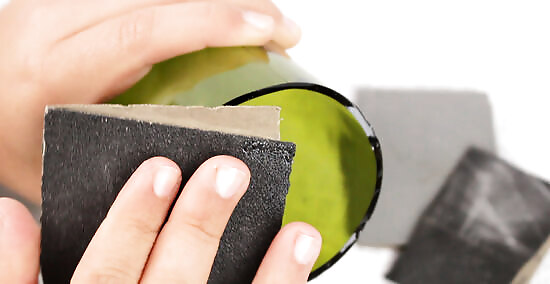
Polish the cut edge with 80-grit sandpaper. While still wearing your gloves, rub a pad of 80-grit sandpaper against the sharp, cut edge of the glass to file it down and smooth it out. Rub back and forth perpendicularly across the edge, and pay special attention to the sharp corners. Sand until it’s totally smooth to the touch, or for about 5-10 minutes. Sand the bottle over a sink to catch any debris, and periodically run the bottle under the tap to keep it wet, which helps to prevent chipping and to achieve a smooth finish.
Adding the Hanging Chain

Cut a chain or length of string long enough to feed through the bottle. This will be the length of chain that the bottle hangs from. Use a measuring tape to measure the neck of the bottle, then add about 12–15 in (30–38 cm) to give the bottle more slack as it hangs. Use a pair of wire cutters or sharp-edged pliers to cut your craft chain to this length. For example, if your bottle's neck measures 3 inches (7.6 cm) and you want your hanging chain to be 14 inches (36 cm) long, cut the chain down to 17 inches (43 cm). It’s better to cut the chain too long than too short. You can always trim it shorter.

Secure a key ring to one end of the chain. Use a key ring that is wider than the neck of your bottle—about 1 inch (2.5 cm) wide should be fine. Feed the ring onto the last link of your chain, or tie it to the end of your string using a strong knot. The key ring will act as a stopper inside the bottle to hold it up. The key ring must be bigger than the neck of the bottle. If it is too small, it won't hold the bottle up.
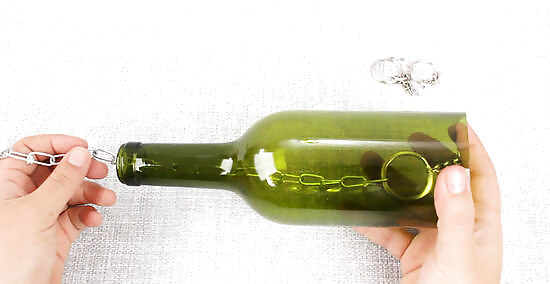
Feed the other end of the chain through the neck of the bottle. Turn the bottle upside down and place the chain inside, holding onto the key ring end. Let the chain fall through the neck of the bottle and out the top. The key ring will sit right inside the neck.
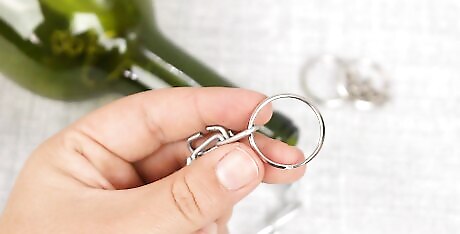
Secure another key ring onto the top of the chain. This will allow you to actually hang the finished wind chime from a hook. Hold the wind chime up by the second key ring; the bottle will slide down the chain and stop at the first key ring.
Adding the Wind Catch
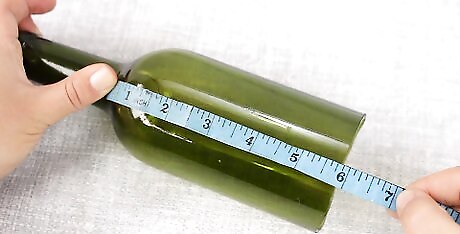
Cut a second chain for the wind catch to dangle from. The wind catch is the little ornament that dangles from the bottom of the wind chime. Hold the bottle up by the chain and note where the key ring sits inside. Measure from this point down to about 1 inch (2.5 cm) from the bottom edge of the bottle. Cut a second piece of chain according to that length. This second length of chain will end at about the level of the cut edge of the bottle.
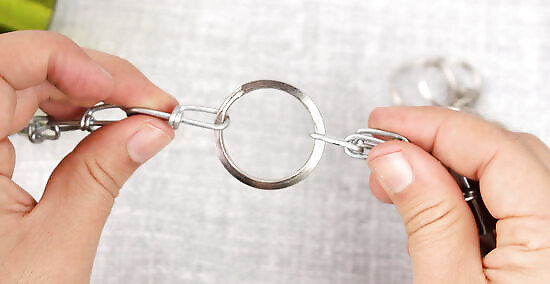
Add the second chain to the key ring inside the bottle. Reach into the bottle and pull out the key ring. Thread the end of your second chain (or tie your string) onto this key ring, then hold your wind chime up again. The end of the second chain is about level with the bottom cut edge of the bottle. You will have 2 chains in your bottle. The first chain sticks up through the neck of the bottle, while the second hangs inside the bottle. If you’re using a string or a cord, add some noise to the chime by threading a large, wooden bead onto the cord, then tie a knot below it so that it sits inside the bottle.

Thread a third key ring to the bottom of the dangling chain. This is your “chime” that makes your windchimes sing by hitting the sides of the bottle. You might alternatively use a washer, beads, or any other heavy object that makes a chime when it strikes the glass.
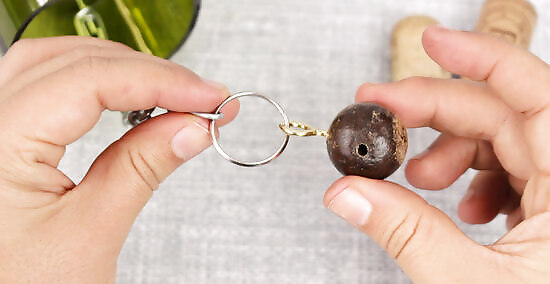
Secure an ornament onto the key ring. The ornament hangs on the very end of the wind chime and provides some weight. A chunky necklace pendant with a built-in hook is ideal, or use a large wooden bead and screw a hook into it yourself. Then secure the ornament to the key ring at the bottom of the chain or string. If you like, add another length of chain or string between the third key ring and the ornament to let the ornament dangle even lower. How low it goes is up to you! Alternatively, use a small bell as the ornament to let your wind chime make a bit more noise. Or, add a smaller glass bottle at the bottom by repeating this process and securing the second bottle to the bottom of the first bottle’s chain.
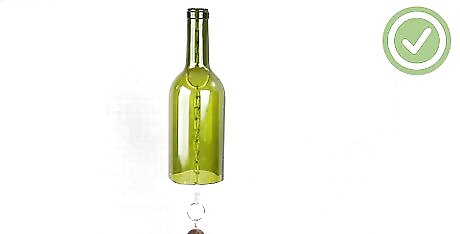
Hang the wind chime using the key ring at the top of the chain. hang your new wind chime outside where the wind will catch it, like from a tree branch or the eave of your home. Or, hang it inside; it may not chime, but it’ll make a nice indoor decoration.




















Comments
0 comment